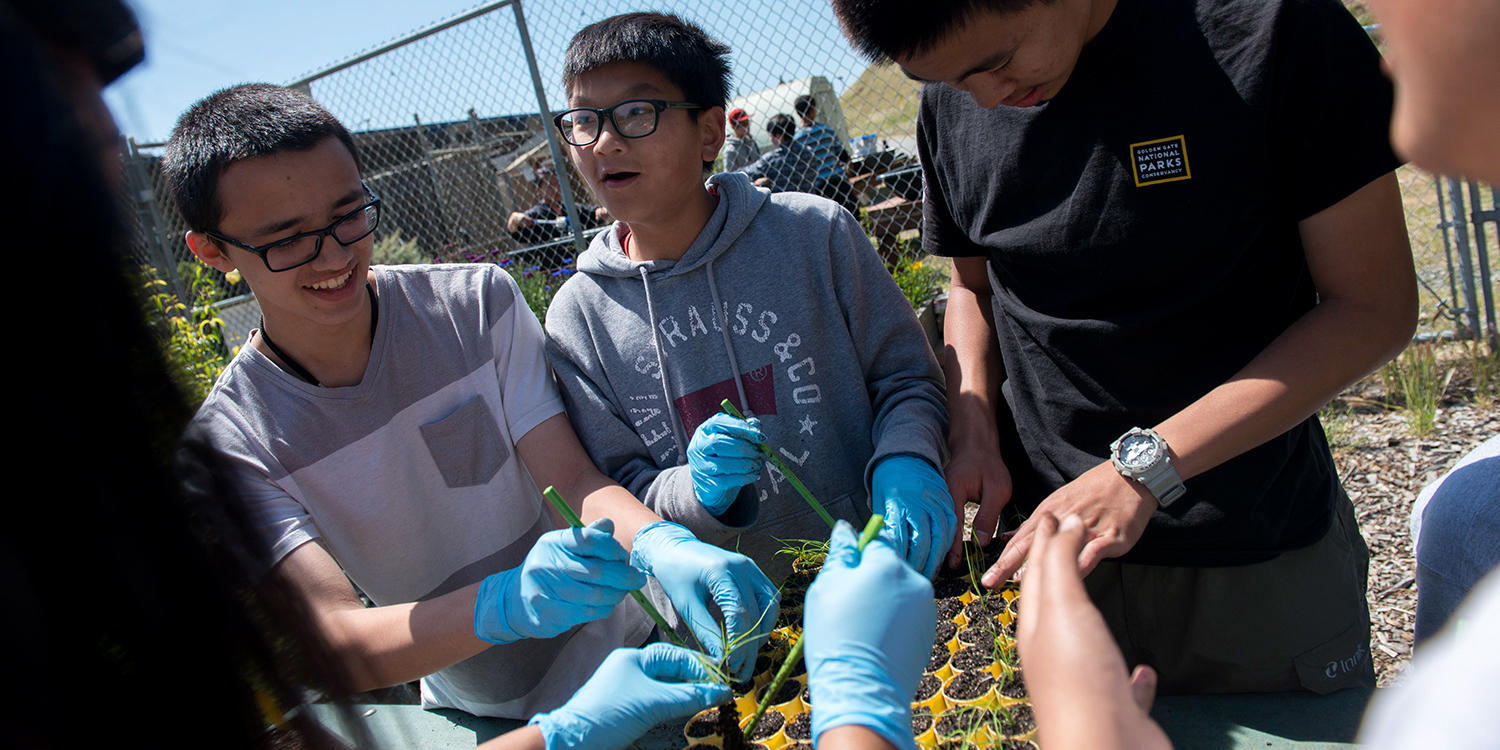Your parks need you now
Your support helps fight climate change and promote park sustainability—please give now.

“This program has given me a sense of purpose in life. I feel at peace whenever I’m volunteering.”
—Noreen Mabini, long-time participant and recent graduate at Oceana High School
For two decades, the native plant nursery and restoration program at Oceana High School has provided students with a direct connection to their national park.
The program, managed by the Golden Gate National Parks Conservancy in cooperation with the Jefferson Union High School District, is focused on the student experience and offers youth the opportunity to grow native plants and restore coastal parklands. In fact, students volunteer right outside their own school at Milagra Ridge in the Golden Gate National Recreational Area.
This year, the students returned to school in August to a re-envisioned nursery campus, including a new greenhouse and shadehouse. According to Park Nurseries Director Alisa Shor, the new space was designed to make as much use as possible of salvaged materials from decommissioned nursery structures from Fort Funston, Tennessee Valley, and Redwood Creek.
The new greenhouse and shadehouse are part of a broader effort at Oceana to improve safety, accessibility, operational efficiency, and the overall experience of program participants.
“The new upgrade provides the students with the opportunity to learn state-of-the-art nursery practices,” says nursery manager Rebecca Blanck-Weiss. “They can see that their volunteer hours are not just busy work, but producing high-quality plants that are enhancing their park.”
Modern nursery facilities like those unveiled this year at the Oceana Nursery are about more than aesthetics. They also allow for cleaner, more sanitary plant production.
Because the plants the students grow are used to restore parklands, it is vital that the plants are healthy. Asked about the impact of the program on the students, Blanck-Weiss says the experience “truly shows that these are their parks and they can change them for the better.”
‘Youth Development is a Top Priority’
While students at Oceana High have to complete 100 volunteer hours by graduation, the Nursery and Stewardship program is about more than just meeting a requirement.
“Youth development is a top priority,” explains Elsa Calvillo, youth programs manager of the Park Stewardship program. According to Calvillo, students often take on big responsibilities, from leading their peers to handling hefty equipment and tools.
“Over the years, there have been many versions of the programs we currently offer,” she says. “But a deep commitment from both the staff at Oceana and the Conservancy has kept the goal of connecting youth to nature the number one priority.”
Decades of Impact
The connection between students and the parklands behind their school began before most of the current volunteers were born.
“The partnership started about 20 years ago, with a curious Environmental Science teacher and welcoming NPS ranger,” Calvillo explains. “Together they realized that the best way to get students to engage in the classroom was to connect the classroom to the field. Not many schools get to say they have a national park in their backyard, so it seemed like a natural partnership to pursue.”
Current students are glad the partnership exists. High school senior Vincent says he volunteers because “it is close to school and available every week, so it’s easy to access.” Another student, 11th grader Daphney, says, “I like this program because you get to be outside and do cool new stuff and meet new people.”
Some of the students have become even more involved, like recent graduate Noreen Mabini. In addition to the weekly drop-in program, Noreen also has participated in three youth internships offered by the Conservancy. “This program has given me a sense of purpose in life,” Noreen says. “I feel at peace whenever I’m volunteering.”
If you would like help change these parks for the better, become a Parks Conservancy member to support the Oceana Nursery and Stewardship program and other conservation and education programs across Golden Gate.
Your donation helps fund:
• Weekly drop-in volunteer program during the school year. Students accomplish a variety of restoration projects, from planting natives to monitoring habitat for the endangered Mission blue butterfly at Milagra Ridge and Mori Point. Students also work at the nursery by transplanting, seed cleaning, and pot washing.
• Education and field trip support for the Environmental Science classes. The Conservancy’s San Mateo Park Stewardship team collaborates with Oceana’s Environmental Science Teacher, Ryan Ready, to facilitate in-class workshops, followed by guided field trips and restoration work.
• Yearly backpacking trip. Led by Conservancy staff, this four-day backpacking program introduces students to backpacking, basic map reading, and navigation skills while nurturing students’ relationship to nature and the national parks.
You can also volunteer at one of the park nurseries Wednesday afternoons or Saturdays.
Your support helps fight climate change and promote park sustainability—please give now.